Welcome to a very important Too Much Information. This time, we will be analyzing the results from Grand Prix Providence, by far the largest Legacy
tournament this year. Actually, this will be the first time a Grand Prix has been featured in a TMI column, which is possible because we have access to
the full match breakdown for the event! Never before have we been able to examine a Grand Prix in such detail.
All of us number crunchers owe a big thanks to Jared Sylva, for putting in the time and effort to collect this information, categorize the decklists,
and create the spreadsheets linking names with deck archetypes. What an undertaking!
For the first time, we’ll be able to look at a Grand Prix in the same way that we’ve been able to look at the StarCityGames.com Opens. The difference
is, with nearly 1200 participants and 8130 matches played, the Providence results are much more statistically compelling than those of any other
individual tournament we have been able to analyze. You can download the spreadsheet to check out the results yourself.
In fact, this huge amount of data lets us make a necessary change: From this point on, we’ll only be using post-New Phyrexia results for matchup
calculations. The set introduced significant changes to the format, and, thanks to the Grand Prix, we now have enough data (over ten thousand matches
in total) that we feel comfortable making the switch. This should help keep both EV calculations and matchup results current.
The following chart displays the field presence and the performance of each archetype that made up more than 1% of the metagame in Providence:
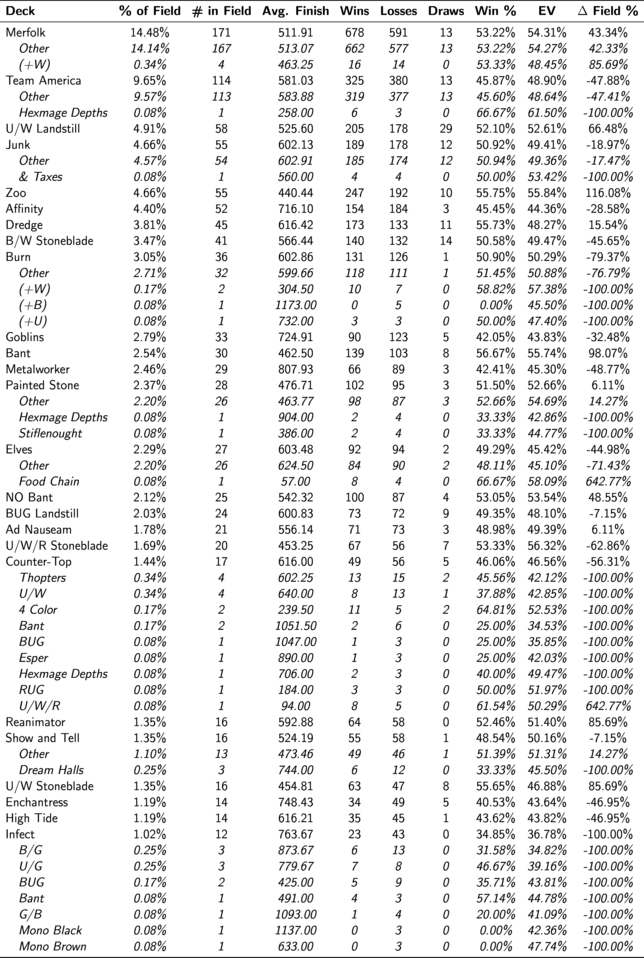
In addition to the usual statistics, we’ve included the relative change in field presence from day one to day two. For example, Zoo was 4.66% of the
field on day one, and that number increased by 116.08% for day two, where 10.06% of the 159 players were playing Zoo. Team America’s presence, on the
other hand, decreased by almost 50% (from 9.65% on day one down to 5.03% on day two). You were about twice as likely to see a Zoo deck on day two as
you were on day one, and you were about half as likely to see a Team America deck on day two as you were on day one. This is just a different way of
looking at how well a deck performed on day one.
As expected, the most popular deck was Merfolk, followed by Team America. Several decks fought for a distant third, with Landstill, Junk Zoo, and
Affinity all representing between four and five percent of the field. This breakdown bears a striking resemblance to that of the Louisville Open, where
the top four decks were Merfolk, Team America, Landstill, and Junk.
Some of the win percentages, however, appear drastically different. Most strikingly, Team America followed up two great showings in the Open Series
with a terrible performance in Providence. If the deck can’t adapt to whatever forces kept it down at the Grand Prix (a 45.8% win record is very poor
for the second-most popular deck), look for its popularity to plummet in future events. On the other hand, Junk, U/W Landstill, and Dredge all
performed better in Providence than they did in the latest Opens. Dredge, in particular, had an extremely good weekend, boasting one of the best win
percentages among common decks.
Bant was the most successful deck of the weekend, not only winning the tournament but also posting the best win percentage in the process. Zoo, Dredge,
and U/W Stoneblade were not far behind, all winning more than 55% of matches. Note that U/W Stoneblade, with only 16 players, gives us a much smaller
sample than the other decks, but it still played as many matches in this tournament (118) as a reasonably popular deck in an average Open!
Counter-Top, which has traditionally been extremely successful at Legacy Grand Prix, was barely present at all. Its popularity has been steadily
declining over the past several months, and its win percentages have been consistently low.
We can also attempt to identify good choices by looking at EVs. The decks with the highest EVs were Zoo, Bant, and U/W/R Stoneblade. For the most part,
we observe that win percentages and EVs tend to be rather close, but there are a couple of anomalies. Team America’s EV was not particularly good at
49%, but its performance was even worse. Dredge, on the other hand, outperformed its EV to post a great record. Since we’ve updated the EV calculation
to use recent matchup data, most of which comes from the Grand Prix itself, the deviations are probably more likely to be due to non-representative
pairings than atypical match results.
Now we’re going to take a look at the matchups between some of the most popular and successful decks. Usually, we focus on decks that were at least 5%
of an Open field because there just isn’t much data for any combination of less popular matchups. Since the Grand Prix was so large, this is much less
of a concern. We’ll look at Merfolk, Team America, U/W Landstill, Junk, Zoo, Affinity, Dredge, and Bant. We’ll also look at the various Stoneblade
decks as a group. While none of them was individually very popular, they add up to a substantial 8.30% of the field. Combined, all of these top decks
had a total of 678 players, or 57% of the field. Once again, the overall records are now only from tournaments for which New Phyrexia was legal: the
Orlando Open, the Louisville Open, and the Grand Prix.
Merfolk – 14.48% of Field – Won 53.22% of Matches
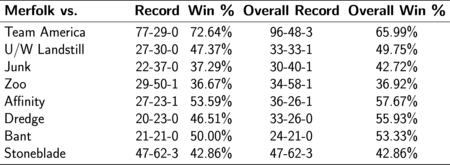
Merfolk remained the most popular deck by a wide margin and put up a strong win percentage against the field. An incredibly favorable matchup against
the second-most common deck in Providence no doubt contributed to its success, but none of the matchups against the other top decks looks great for
Fish. It posted a slightly positive record against Affinity, but all the other matchups were even or worse. Junk and Zoo continue to convincingly beat
Merfolk, and Stoneblade appears to be favored against it as well. Merfolk’s Landstill, Dredge, and Bant matchups all seem close to even. Merfolk
demonstrates that, in a field as diverse as Legacy, a deck can remain strong against the field even if it isn’t outstanding against many of the top
decks.
Team America – 9.65% of Field – Won 45.87% of Matches
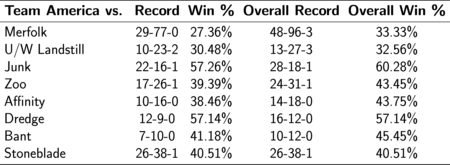
Team America posted an even poorer record against the other top decks, which, in this case, did result in a poor overall performance. Not only does the
deck seem to have a terrible Merfolk matchup, but a terrible Landstill matchup as well. When a deck’s best matchup among the three most popular decks
is its mirror, it’s in a bad spot. To make matters worse, TA also lost most of its matches against Zoo, Affinity, Bant, and Stoneblade. The only
positive records in this table are against the much less common Junk and Dredge, and even there Team America is not ahead by very much, in relation to
its bad matchups. Team America performed well in the last two Opens, leading to its explosion in popularity, but the metagame seems very hostile to the
deck right now.
U/W Landstill – 4.91% of Field – Won 52.10% of Matches
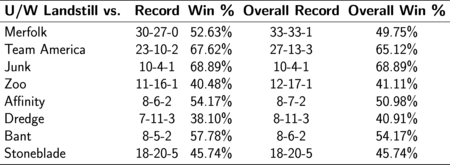
U/W Landstill continues to gain popularity following its initial success in Orlando, and its record at the Grand Prix shows that the deck’s lack of
success in Louisville may have been a fluke. It’s a blue-based control deck that doesn’t lose to Merfolk, although it doesn’t appear to be favored
either. Landstill also seems to be about even with Stoneblade. It was decidedly ahead against Team America. We don’t have very much data for
Landstill’s other matchups, but it has positive records against Junk, Bant, and Affinity, and negative records against Zoo and Dredge. If Landstill
holds on to its position in the metagame, which it seems likely to do, we’ll learn more about these matchups very soon.
Junk – 4.66% of Field – Won 50.92% of Matches
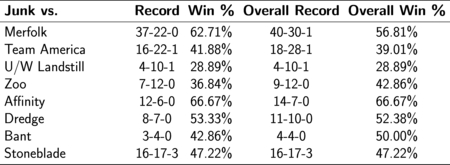
Junk’s middle-of-the-road win percentage at the Grand Prix is a step up from its performance in the previous two Opens. Last time, we saw that it went
3-8 against Merfolk over Orlando and Louisville, but now, with a much larger sample, we can see that the matchup is still in Junk’s favor. On the other
hand, Junk loses to Team America, Landstill, and Zoo. The only other deck it was definitively favored against is Affinity. Junk is yet another deck to
have a nearly even Stoneblade matchup.
Zoo – 4.66% of Field – Won 55.75% of Matches
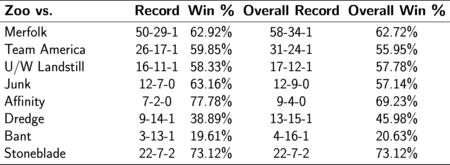
Unlike Merfolk, it’s easy to see why Zoo had an amazing weekend just by looking at this list. Zoo posted great records against the other five most
popular individual decks, as well as the significant group of Stoneblade decks. Zoo is always going to be reasonably well-positioned as long as Merfolk
is on top, but this time the metagame was even better for it, with several good matchups being more popular than usual and most of its bad matchups
nowhere in sight.
Zoo did lose, however, to both Dredge and Bant. The Dredge result is interesting, since Zoo had been performing well against Dredge throughout the
year. The numbers are somewhat small, so it’s unclear whether this is a result of Zoo players’ sideboards, the variance in a very close matchup, or
some other factor. The loss to Bant is a much larger swing—Zoo was 7-3 against Bant prior to New Phyrexia. This could be a matchup that was
seriously affected by Mental Misstep. Note that this doesn’t include NO Bant, which Zoo never had a great matchup against, but that matchup, too, may
have gotten even worse: before New Phyrexia, Zoo’s record against NO Bant was 8-13. At the Grand Prix, it was 0-8.
Affinity – 4.40% of Field – Won 45.45% of Matches
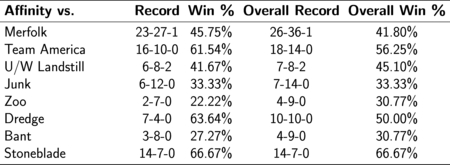
Affinity’s overall record continues to look dismal, but some of its matchup results are interesting. Over the past three tournaments, it’s been
slightly behind against Merfolk, where it was slightly ahead before. The Junk matchup does not appear as close as it previously did. Affinity’s good
record against Stoneblade and bad record against Bant are worth noticing. The good matchup against Team America and bad matchup against Zoo agree with
the pre-New Phyrexia results.
Dredge – 3.81% of Field – Won 55.73% of Matches
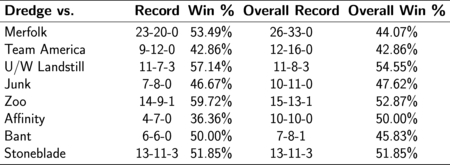
Dredge did extremely well at the Grand Prix, despite struggling some in recent Opens. Much like Merfolk, its success seems to have come more from its
matches against the rest of the field than its matches against the top decks. The matchups shown above appear to be very close, fluctuating from
slightly below even to slightly above even between tournaments— we’ve reported win percentages on both sides of 50% for the Merfolk, Team
America, Junk, Zoo, and Affinity matchups.
Bant – 2.54% of Field – Won 56.67% of Matches
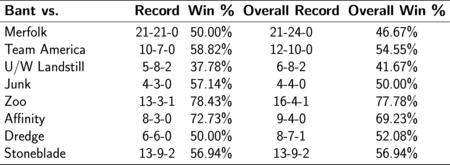
Bant was much less popular than any of these other decks were, but it’s important to examine because it’s been very popular in the past, its win
percentage was extremely high, and, of course, it won the Grand Prix!
And looking at these matchups, the deck’s success isn’t surprising. It has a weak Landstill matchup, but it goes even or better with everything else.
“Only” splitting with the most popular deck, Merfolk, is a little disappointing, but you can’t argue with the rest of those numbers.
Stoneblade – 8.30% of Field – Won 52.18% of Matches
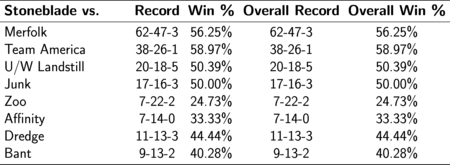
Now, we come to the new kid on the block. Remember, this table uses numbers generated by lumping all of the Stoneforge Mystic decks together, which
gives us enough data to begin examining matchups for this strategy. What we see is a mixture of good and bad, from positive matchups against the most
popular decks (very good) to abysmal matchups against some of the less popular decks (pretty bad).
Normally, it might seem strange to see a deck do so well against Merfolk, but have such difficulty beating other aggro decks, like Zoo and Affinity.
This is probably tied to the disparity in Stoneforge Mystic’s effectiveness (and that of Equipment, in general) against each of those decks. In other
words, Stoneforge for Batterskull might be great against Cursecatcher, but it is much worse against Grim Lavamancer.
Grand Prix Providence promises to massively impact the Legacy metagame, and, as always, it will be fascinating to see how the format reacts.
Team America’s prevalence is likely to decrease in the wake of its lack of success at the Grand Prix. This is a bad thing for Merfolk, but expect that
deck to remain a solid choice regardless. Of course, Merfolk won’t be going anywhere—there’s no reason to expect it to be anything less than the
most played deck in the foreseeable future. We’ll probably see an increase in the number of Bant and possibly Zoo players as a result of their recent
victories, and both look like extremely strong decks to play right now.
With sizeable representation in the field and a good win percentage, Stoneblade will probably remain a significant deck. A variety of color
combinations were played at the Grand Prix, with B/W, U/W/R, and U/W being the most common. It will be very interesting to see how the archetype
develops, and whether it settles on a standard build.
Hive Mind and NO RUG are two decks that did very well at the Grand Prix (not only making Top 8 but posting very high win percentages of 57.78% and
56.11%, respectively) and placed in the Denver Open. We can certainly expect to see more of these decks in the future. We don’t have enough data to
look at their matchups at the Grand Prix, but we’ll probably be able to look at their matchups in the Opens soon.
The Grand Prix not only gives us our first detailed look at post-New Phyrexia Legacy but will prove to be an influential force itself. Each Legacy
Grand Prix has been an important moment in the history of the format, causing significant metagame shifts, and Providence will be no exception. Many
results from the Grand Prix were expected, like Merfolk maintaining its position as the top deck. Some were more noteworthy, like Bant’s great
performance and Landstill’s return to prominence. Others were completely new, like the appearances of Stoneblade and Hive Mind. These developments are
sure to affect the format profoundly, and we’ll be excited to analyze the resulting changes as the Open Series continues on.
